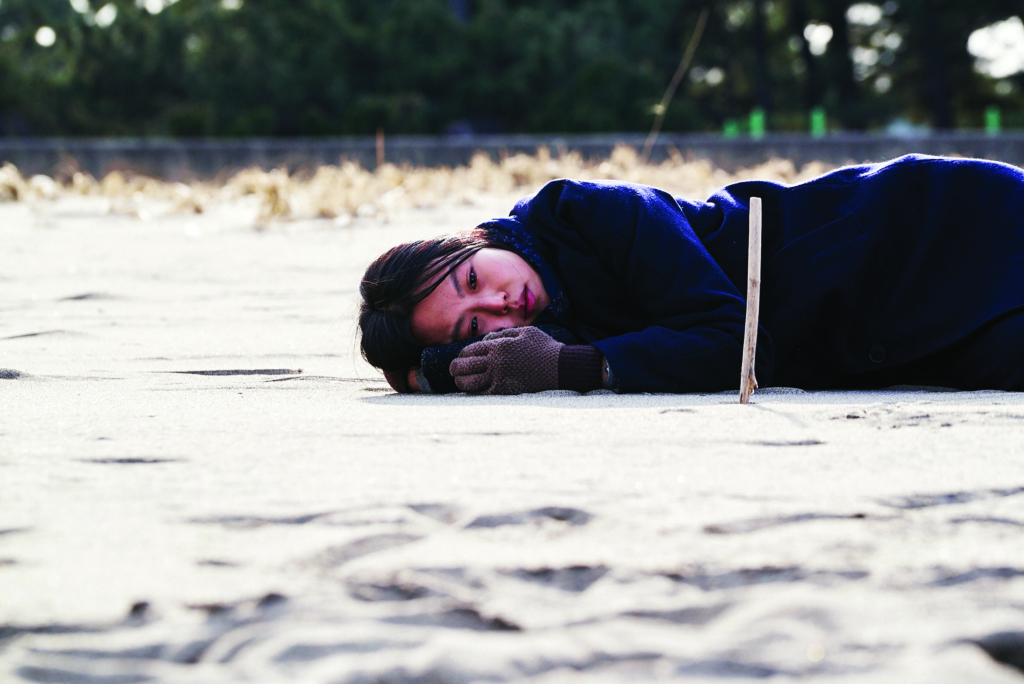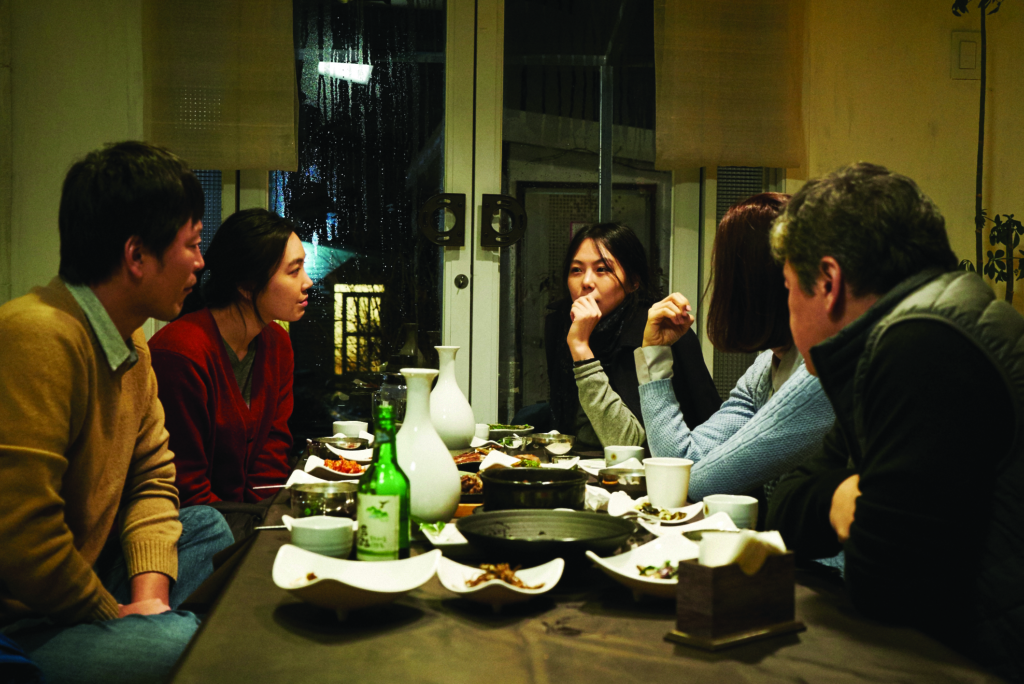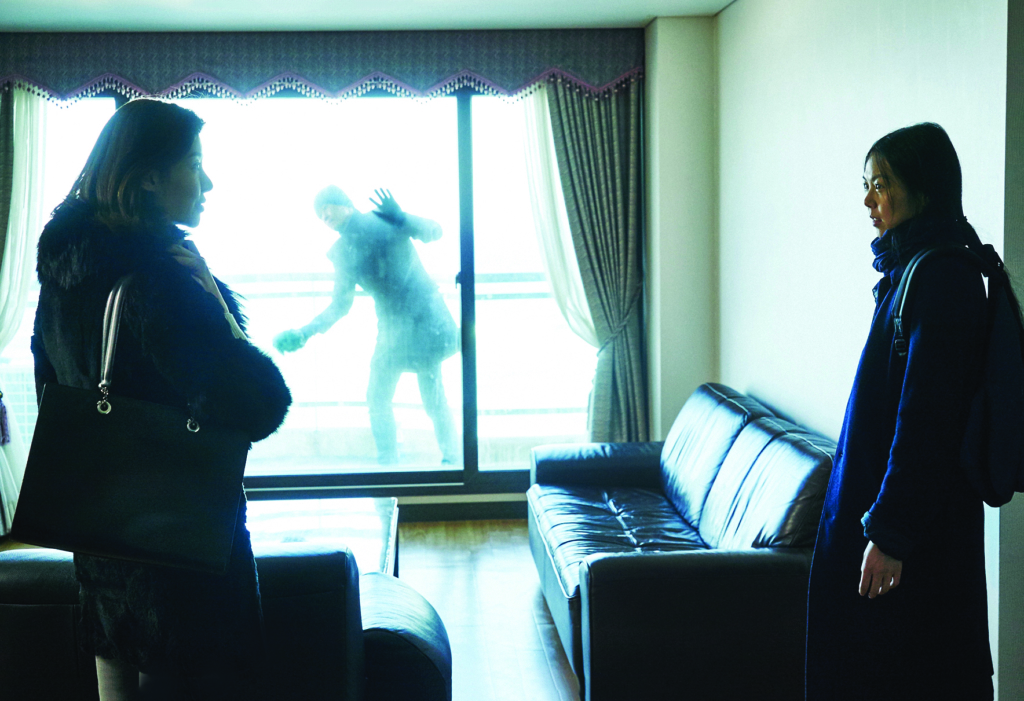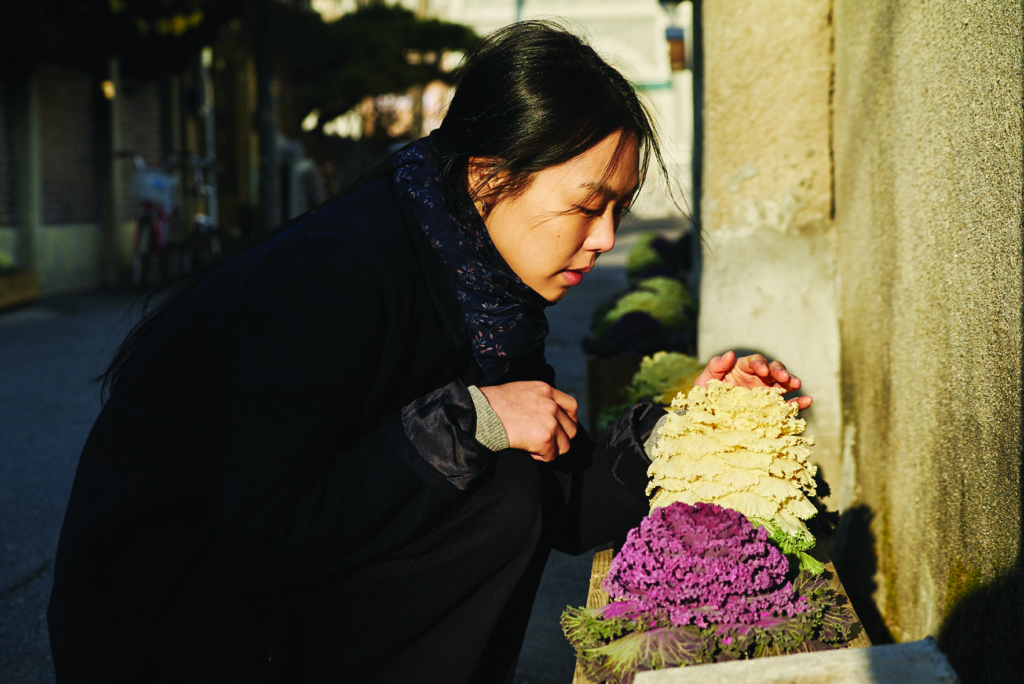As two women approach a bridge, one abruptly stops, kneels down and prostrates herself. The other walks on – obliviously at first, and then, having glanced backwards, more hesitantly. Later, as they sit together on a park bench, the topic is furtively raised: what was the purpose of this act? ‘[It was] just a prayer,’ the first explains, ‘to try resolving what it is I really want.’
There are many such bridges in On the Beach at Night Alone (Hong Sang-soo, 2017), though mostly of the metaphorical variety: the plane trip that might reunite geographically separated lovers; flailing attempts to connect via language; the moment of waking from a dream. Physical contact, the elimination of empty space between people, is also a bridge; but here it is mostly absent, making the film’s fleeting moments of touch – an experimental kiss, a hand offered and held – all the more charged, desperate.
The film’s most consequential acts of bodily intimacy lie beyond the frame. In the opening scenes, Young-hee (Kim Min-hee), a South Korean actor, is in Germany, having fled the brutal public examination of her affair with a married director. We never see the salacious newspaper headlines or the hate-filled social-media posts about the scandal, and we scarcely need to. Australian viewers familiar with the spiteful, prurient recent media coverage of former deputy prime minister Barnaby Joyce’s affair with his staffer,[1]See, for example, Amanda Meade, ‘The Gift That Keeps on Giving: 10 Joyce Splashes in a Row at the Tele’, The Guardian, 16 February 2018, <https://www.theguardian.com/media/2018/feb/16/the-gift-that-keeps-on-giving-10-joyce-splashes-in-a-row-at-the-tele>, accessed 7 March 2018. for instance, will be able to more than adequately fill in the blanks. In one of the film’s rare moments in which Young-hee is out of the frame, two of her friends discuss this culture of gossip and judgement: ‘Just leave them alone,’ Chun-woo (Kwon Hae-hyo) grumbles to Jun-hee (Song Seon-mi). ‘Why stir up such a fuss?’ She shrugs: ‘People have nothing to do and it’s adultery.’ Chun-woo shakes his head: ‘People must’ve had fun, raking them over the coals. They can act cruel, but two people in love is immoral?’

Hong has intimate familiarity with this kind of public shaming. The narrative of On the Beach at Night Alone seems to be closely modelled on his own affair with Kim, who was previously the star of his 2015 film Right Now, Wrong Then.[2]C Hong, ‘Kim Eui Sung Defends Hong Sang Soo and Actress Kim Min Hee’s Relationship’, Soompi, 26 May 2017, <https://www.soompi.com/2017/05/26/kim-eui-sung-defends-director-hong-sang-soo-actress-kim-min-hees-relationship/>, accessed 7 March 2018. Here, thus, she inhabits a meta-role, the vilified ‘other woman’ of the tabloids refracted into a fictional version of herself. This is not an unusual tactic for the filmmaker: a strong autobiographical streak runs through much of Hong’s work, the protagonists of which are often directors or actors with suspiciously similar character traits, the same archetypes cropping up again and again (sometimes even multiple times in the same film). If this seems a little self-indulgent, it is a charge he seems more than willing to confront: in a climactic scene, Young-hee yells at Hong’s thinly veiled avatar, director Sang-won (Mun Seong-kun), ‘It’s boring to talk about yourself all the time.’
Be that as it may, talking is one of the things that Hong’s films do best. Scenes are structured around conversations, which are often as revealing in their omissions as in what is actually said. Many of On the Beach at Night Alone’s humorous moments emerge from repetitions and banalities (‘I’ve come to really like apples these days’); nonetheless, its characters are also capable of honestly conveying their interior states (‘This pain, this constant regret […] with time, it turns sweet’). This combination of speech-as-confession and speech-as-obfuscation is common to a rich tradition of dialogue-oriented, aesthetically modest cinema exemplified by filmmakers such as Éric Rohmer, Jean Eustache and Joe Swanberg. Rohmer, in particular, seems to have been an influence on Hong’s style. Comparisons between the two directors’ work are common[3]Richard Brody, ‘Hong Sang-soo: Modern Mastery’, The New Yorker, 9 February 2011, <https://www.newyorker.com/culture/richard-brody/hong-sang-soo-modern-mastery>, accessed 7 March 2018. – Rohmer, too, privileges the act of merely sitting around and talking without clear narrative progression, an approach that challenges our conception of what is cinematic – and Hong has listed the French New Wave pioneer’s The Green Ray (1986) as one of his favourite films.[4]Jordan Raup, ‘Hong Sang-soo’s 10 Favorite Films’, The Film Stage, 13 November 2017, <https://thefilmstage.com/news/hong-sang-soos-10-favorite-films/>, accessed 7 March 2018.
Scenes are structured around conversations, which are often as revealing in their omissions as in what is actually said. Many of On the Beach at Night Alone’s humorous moments emerge from repetitions and banalities.
In Hong’s cinema, characters are often framed from a middle distance, in discrete shots; rarely does he cut within scenes. Instead, every now and then, the static frame is interrupted by a single movement, like a zoom or a slow pan – a distinctive feature of his films that lends a not-quite-cinema-vérité sensibility to them, as if to periodically remind us that he and his crew are there. Absent in many of Rohmer’s films, non-diegetic music often has a presence in Hong’s; in On the Beach at Night Alone, interludes are marked by passages from Franz Schubert’s String Quintet in C Major. But talk, whether it be funny, banal or perceptive, is always front and centre.
In the first part of the film, discussions primarily take place between Young-hee and Jee-young (Seo Young-hwa), her host in Hamburg. Jee-young’s mixture of forthrightness (she flatly rejects Young-hee’s suggestion that they live together) and unsentimental affection for her guest makes her one of the film’s most compelling characters, an older divorcee who appears to find contentment in her own quiet rhythms and habits. It is all the more jarring, then, when she disappears from the story around the thirty-minute mark, as the narrative abruptly spirits Young-hee away to Gangneung in South Korea and to a new set of friends and acquaintances.

The German and South Korean sections offer opportunities for contrasting cultural observations. ‘Men here are kind. They’re gentle,’ remarks Young-hee in Hamburg, a line that resonates when, in the second part, she is accosted and brusquely interrogated by Chun-woo outside a cinema – an interesting inversion of the Western trope of the feminised Asian man.[5]Julia Meszaros, ‘Elliot Rodger and the Effeminization of Asian Men’, The Huffington Post, 30 May 2014, <https://www.huffingtonpost.com/julia-meszaros/elliot-rodger-and-the-effeminization-of-asian-men_b_5401516.html>, accessed 7 March 2018. But Hong is also interested in mirrors. In his other works, such as The Day He Arrives (2011), that has manifested in entire scenes being repeated with different consequences, as if in a parallel universe, or, as in Tale of Cinema (2005), the staging of films within films; here, however, the reflections are smaller and subtler, contained in recurring situations and snatches of dialogue. At the conclusion of each segment, Young-hee finds herself on a beach, conjuring her absent lover in some manner: by drawing his face in the sand and, later, by falling asleep and dreaming of him.
An element common to each of the Hamburg and Gangneung sections – and, besides the protagonist, the only character who appears in both – is an unnamed man in a black coat and beanie (played by Kong Hong-yeol). At times, he mostly seems a comic diversion: in his first appearance, he runs up to Young-hee and Jee-young in a park to ask for the time, only to be met with blank looks; later, in an extended sequence, he enthusiastically cleans a window in the background while the other characters inspect an apartment, seemingly oblivious to his presence. Elsewhere, though, he fulfils a more opaque function, seen looking out to sea pensively or casually carrying off an unconscious Young-hee in the surreal final shot of the Hamburg chapter. One could imagine him as the protagonist of another film about loneliness; or, perhaps, he is more like the ‘watcher’ figure (Artur Barciś) from Krzysztof Kieślowski’s Dekalog, a guardian angel who sympathetically observes the affairs of humans without ever becoming directly involved.
Loneliness is a key thread running through On the Beach at Night Alone. It’s not that its characters often lack for human interaction but more that the exchanges the characters do have sometimes only serve to increase their emotional isolation, functioning less as bridges than fissures.
Loneliness is a key thread running through On the Beach at Night Alone. It’s not that its characters often lack for human interaction – Young-hee, at any rate, seems to be content with the idea of having a good deal less of it – but more that the exchanges the characters do have sometimes only serve to increase their emotional isolation, functioning less as bridges than fissures. This is seen most clearly in the troubled dynamic between Myung-soo (Jeong Jae-yeong) and Seon-hee (Ahn Sun-yeong), a couple who seemingly have vastly differing perceptions and expectations of their relationship, and are mostly skilled at annoying and alienating each other. Likewise, Young-hee – an apparently accomplished actor who frequently receives compliments about her charm and physical appearance – seems to have no lack of admirers, but these sentiments are far from reciprocated; she often seems to be on a different page to the people around her.
When she is asked about her time in Hamburg over soju, the picture she presents is wildly different from what we have seen in the film’s first part: one of casual sex and social isolation, in which her interactions with Jee-young have been erased entirely. In that light, her earlier offer to move in with Jee-young starts to seem as frivolous as her subsequent drunken suggestion to Jun-hee (Song Seon-mi) that they ‘get rid of all the men’ and embark on a lesbian relationship. There’s a self-absorption, even narcissism, in these declarations, a nonchalance that seems to suggest an inability to fully relate to others. At first, that disaffection manifests as misanthropy – ‘Everyone’s cowardly, satisfied with fake things and engaging in dirty acts’ – but, later, it turns inwards: ‘I’m destructive,’ she explodes in the film’s penultimate sequence. ‘I harass people and I destroy everything!’ That the setting in which this anguished claim occurs turns out to be a dream tells us something profound about Young-hee’s inner turmoil, her feelings of guilt and desire for catharsis. She has spent much of the film talking about herself, but this is the moment in which we gain the deepest insights into her character.

Dreams have often been used in cinema to convey characters’ fears and desires. What’s remarkable about this sequence, though, is that the dream functions as the narrative’s denouement – and an emotionally satisfying one, at that. In the first of its scenes, Young-hee seemingly wakes on the beach to find a film crew (sans director) standing around a fire pit. It is immediately apparent that they are working on her ex-lover Sang-won’s production, and they invite her out for a late-night drink. Until this point in the film, it appears that she has had no further contact with the director, his emailed promise to join her in Hamburg apparently unfulfilled. Yet here, at last, he is: a man who we see now is much older than she is, his hair greying (‘You’re like a grandfather all of a sudden,’ she remarks), seemingly with another woman on his arm, in the intimacy-deprived setting of a group rendezvous. The tension is evident as pleasantries are quickly rebuffed and a heated exchange ensues, leading to Sang-won breaking down in tears and reading her a passage from a book that he gifts her:
When our eyes met in that cabin, our self-restraint deserted us […] I confessed my love for her and, with a burning pain in my heart, I realised how unnecessary, how petty and how deceptive all that had hindered us from loving was.[6]An excerpt from an 1898 short story by Anton Chekhov, ‘About Love’.

When Young-hee wakes up on the beach – this time, for real, revealing the previous two scenes to have been imagined – the film’s narrative has not been undermined or subverted. Instead, it feels entirely consequential: whether or not she reconciles with Sang-won in real life, she has experienced the resolution she craved. Rarely do films make such a profound statement about the nature of dreams, or the functional role they play in our lives – not as side-steps from reality, but rather as sequential components of a continuous experience of qualia. In the final shot, Young-hee gets up, sand still clinging to her clothes. A bridge has been crossed.
Endnotes
| 1 | See, for example, Amanda Meade, ‘The Gift That Keeps on Giving: 10 Joyce Splashes in a Row at the Tele’, The Guardian, 16 February 2018, <https://www.theguardian.com/media/2018/feb/16/the-gift-that-keeps-on-giving-10-joyce-splashes-in-a-row-at-the-tele>, accessed 7 March 2018. |
|---|---|
| 2 | C Hong, ‘Kim Eui Sung Defends Hong Sang Soo and Actress Kim Min Hee’s Relationship’, Soompi, 26 May 2017, <https://www.soompi.com/2017/05/26/kim-eui-sung-defends-director-hong-sang-soo-actress-kim-min-hees-relationship/>, accessed 7 March 2018. |
| 3 | Richard Brody, ‘Hong Sang-soo: Modern Mastery’, The New Yorker, 9 February 2011, <https://www.newyorker.com/culture/richard-brody/hong-sang-soo-modern-mastery>, accessed 7 March 2018. |
| 4 | Jordan Raup, ‘Hong Sang-soo’s 10 Favorite Films’, The Film Stage, 13 November 2017, <https://thefilmstage.com/news/hong-sang-soos-10-favorite-films/>, accessed 7 March 2018. |
| 5 | Julia Meszaros, ‘Elliot Rodger and the Effeminization of Asian Men’, The Huffington Post, 30 May 2014, <https://www.huffingtonpost.com/julia-meszaros/elliot-rodger-and-the-effeminization-of-asian-men_b_5401516.html>, accessed 7 March 2018. |
| 6 | An excerpt from an 1898 short story by Anton Chekhov, ‘About Love’. |





